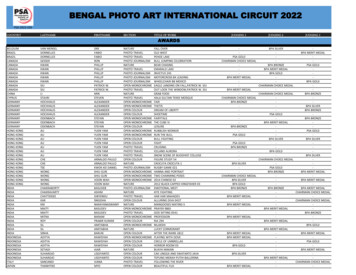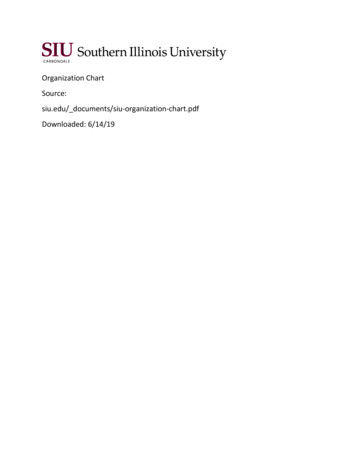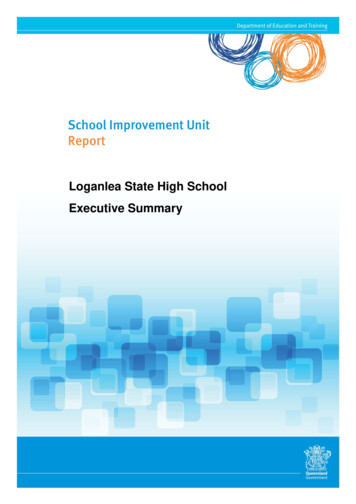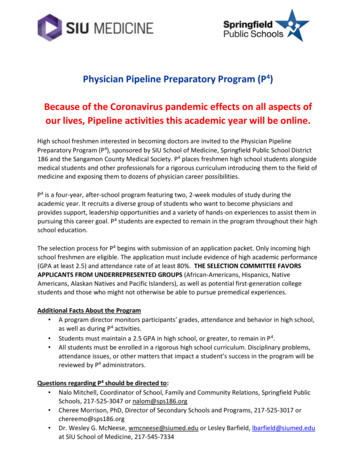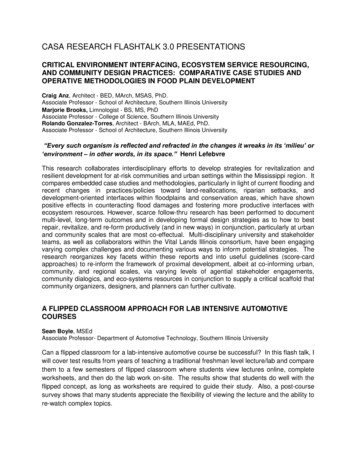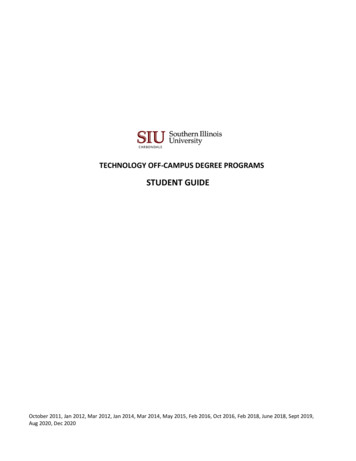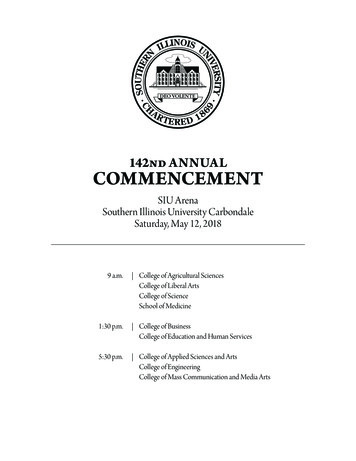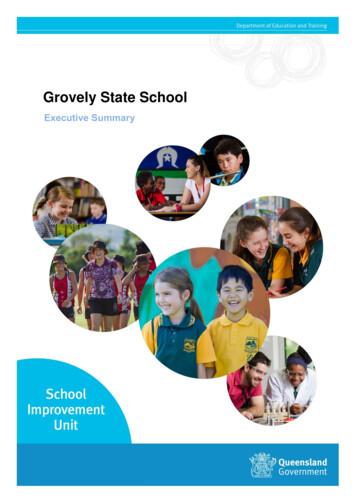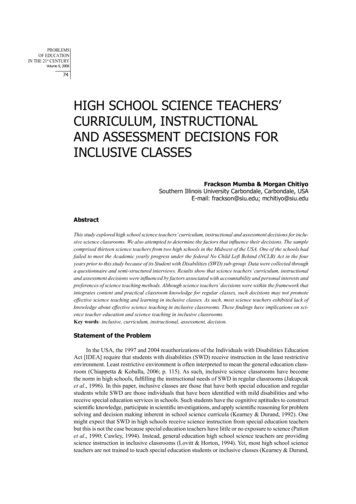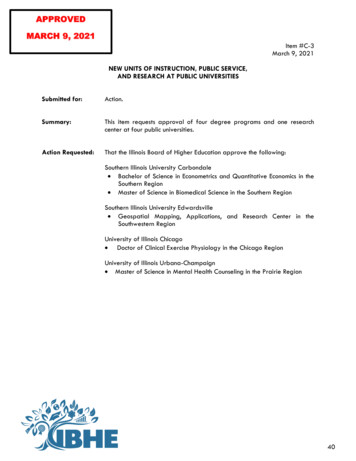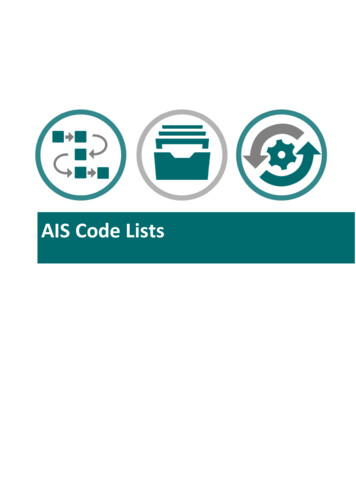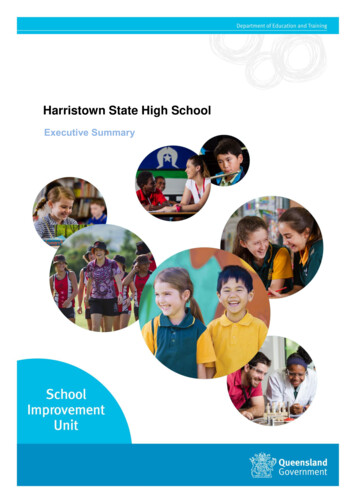
Transcription
Harristown State High School
Contents1. Introduction . 31.1 Review team . 31.2 School context . 41.3 Contributing stakeholders . 51.4 Supporting documentary evidence. 52. Executive summary . 62.1 Key findings . 62.2 Key improvement strategies . 82
1. IntroductionThis report is a product of a review carried out by a review team from the SchoolImprovement Unit (SIU) at Harristown State High School from 15 to 18 May 2017.The report presents an evaluation of the school’s performance against the nine domains ofthe National School Improvement Tool. It also recommends improvement strategies for theschool to consider in consultation with its regional office and school community.The report’s executive summary outlines key findings from the review and key improvementstrategies which prioritise future directions for improvement.The schools will publish the executive summary on the school website within two weeks ofreceiving the report.The principal will meet with their Assistant Regional Director (ARD) to discuss the reviewfindings and improvement strategies.For more information about the SIU and reviews for Queensland state schools please visitthe SIU website.1.1 Review teamAlan SampsonInternal reviewer, SIU (review chair)John BrewPeer reviewerSharon AmosPeer ReviewerWayne TroyahnPeer ReviewerRosemary HornExternal reviewer3
1.2 School context4Location:South Street, HarristownEducation region:Darling Downs South West RegionThe school opened in:1955Year levels:Year 7 to Year 12Current schoolenrolment:1671Indigenous enrolments:14 per centStudents with disabilityenrolments:7 per centIndex of CommunitySocio-EducationalAdvantage (ICSEA)value:947Year principalappointed:2010Number of teachers:125.45Nearby schools:Harristown State School, Concordia LutheranCollege, St Anthony’s Catholic Primary SchoolSignificant communitypartnerships:Southern Vale Cluster, Clontarf Foundation,Police-Citizens Youth Club (PCYC), Hawk A & IAdvisory Table, Adolescent Mental Health Unit,Bunnings, Binnacle Training, WilsontonAgricultural Field Study Centre (WAFSC)Unique schoolprograms:Academic Academy, Industrial Skills Academy,Sporting Academies, Annex programs,Steps2Success, English as an AdditionalLanguage or Dialect (EAL/D) Intensive programs
1.3 Contributing stakeholdersThe following stakeholders contributed to the review:School community: Principal, 15 members of the school leadership team, Parents and Citizens’Association (P&C) president, 13 parents, guidance officer, 88 teachers, BusinessServices Manager (BSM), three cleaners, three canteen staff members, 84students, five teacher aides, Attendance and Education Queensland International(EQI)officer, three science operations officers, school chaplain, four studentschool captains, eight junior school student leaders, four administration officersand principal’s personal assistant.Community and business groups: School-based police officer, school-based youth health nurse, ClontarfFoundation coordinator and three support workers, and lollipop attendant.Partner schools and other educational providers: Chairperson Harristown Cluster Schools.Government and departmental representatives: State Member for Toowoomba South District and ARD.1.4 Supporting documentary evidenceAnnual Implementation Plan 2017Explicit Improvement Agenda 2017Investing for Success 2017Strategic Plan 2014-2017Headline Indicators (2016 release)School Data Profile (Semester 1 2017)OneSchoolSchool budget overviewProfessional learning plan 2017Curriculum planning documentsSchool improvement targetsSchool differentiation plan or flowchartSchool pedagogical frameworkProfessional development plansIndividual Curriculum PlansSchool newsletters and websiteResponsible Behaviour PlanSchool Opinion SurveyCurriculum, assessment and reportingframeworkStudent Planners5
2. Executive summary2.1 Key findingsStudents, parents and staff members applaud the culture of the school that welcomesall.The school boasts a wide variety of formal and informal curriculum offerings provided forstudents across the school. Community members, students, parents and staff memberscommend and celebrate the improving status and profile of the school in the broadercommunity.School leaders regularly celebrate and reward progress in the areas of attendance,achievement and behaviour.The school leadership team is clearly committed to finding ways to improve current studentoutcomes and have high expectations for student engagement, behaviour and academicoutcomes.The leadership team has established an improvement agenda in Teaching,Engagement, Reading and Mental Health (TERM).Some of the priority areas have detailed action plans resulting from collaborative planning.Explicit whole-school targets are set and communicated to staff members. Most teachersarticulate and apply school targets for student learning to their classroom planning andpractice. The rigour and depth of the review of progress in line with school priorities is not yetconsistent across the school.The school leadership team accepts personal responsibility for driving improvementsin teaching.School leaders place a high priority on evidence-based strategies to drive schoolimprovement. Staff members comment on the high visibility of the principal around theschool in the context of teaching and learning. The school utilises a written, explicit andcomprehensive pedagogical framework based on Dimensions of Learning and ExplicitInstruction (EI) from the work of Marzano1 and Archer2. The Dimensions of Learningframework appears to not yet be implemented consistently across the school.1Marzano, R. J., Pickering, D., Arredondo, D. E., Blackburn, G. J., Brandt, R. S., & Moffett, C. A.(1992). Dimensions of learning. Alexandria, VA: Association for Supervision and CurriculumDevelopment.2Archer, A. L., & Hughes, C. A. (2011). Explicit instruction: Effective and efficient teaching. GuilfordPress.6
Staff members utilise OneSchool and the data dashboard as a starting point foraccessing information and planning for the students they teach.All teachers use the dashboard to record student positions on a classroom differentiationplacemat at the beginning of the year. The use of the placemat in guiding pedagogy andcurriculum planning throughout the year is not yet consistent across the school.The school provides a diverse range of curriculum offerings to cater for the academic,cultural, and wellbeing needs and interests of all students.A documented curriculum plan details the school-wide expectations for curriculum design.Approaches to planning, assessment and delivery are outlined in the plan to supportcurriculum development and ensure consistent learning expectations. Consistent practicesaligned to the Australian Curriculum (AC) regarding assessment for learning are, as yet, lessapparent.The school is well-recognised and highly valued by the community.Community members, parents, students and staff members speak of a strong sense ofcommunity and belonging to a school that is committed to maximising the learningopportunities of every student. An extensive range of mutually beneficial relationshipsbetween the school and community agencies have developed over time to enhance studentoutcomes.7
2.2 Key improvement strategiesDevelop, monitor and provide consistent instructional feedback by leaders on the applicationof classroom learning targets in line with the school’s improvement agenda.Review the school’s pedagogical framework and implementation process to sharpen thealignment of the various pedagogical approaches including consistency in the application ofteacher observations and the provision of feedback.Develop an explicit plan to detail how curriculum should be delivered consistently across theschool, including roles and responsibilities of leaders and timelines for implementation.Build the use of the classroom placemat to be a working document that informs curriculumand pedagogical differentiation throughout the year and is supported by a consistent processof review and feedback from leaders.8
documented curriculum plan details the school-wide expectations for curriculum design. approaches to planning, assessment and delivery are outlined in the plan to support curriculum development and ensure consistent learning expectations. consistent practices aligned to the australian curriculum (ac) regarding assessment for learning are, as
